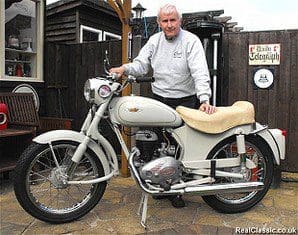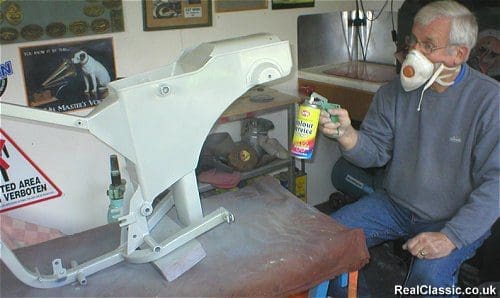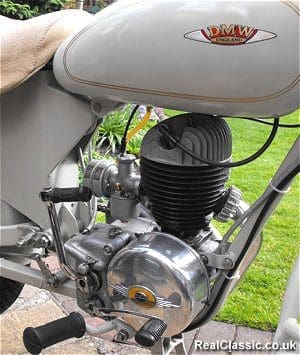
Mick Knowles was born within a mile of Dawson’s Motors at Wolverhampton, so when he saw this DMW for sale he was smitten by a bad attack of ‘nostalgic must have’.
The P200 De Luxe uses the 197cc Villiers 6E engine with three-speed gearbox, but is rather more remarkable for its interesting springing. The firm’s founder, Leslie Dawson, was a popular grass track rider of the 1920s and 30s who designed and built many competition machines and patented several solutions to those common braking and suspension obstacles of the era. Dawson opened his own garage in the early 1940s, turning his technical expertise to develop his ‘Telematic’ forks which were launched in 1942. These were telescopic spring and pneumatic forks which came in a DIY kit form, and were joined by a rear conversion kit a year later.
 After the War, Dawson began building racing machines under his DMW marque, then he joined forces with local businessman Harold Nock, who ran the Metal Profiles company. As Dawson faded from the concern so DMW began to build more road bikes for the wider public, using Villiers engines from 1950. By 1951 DMW used a frame made from square section tubing, with clever snail-cam adjustment for the rear chain and Metal Profiles leading link forks – just a little bit more trick than the average Bantam! By 1954, DMW were building an electric-start model, the Dolomite, which could reach 72mph and which cost £240 new.
After the War, Dawson began building racing machines under his DMW marque, then he joined forces with local businessman Harold Nock, who ran the Metal Profiles company. As Dawson faded from the concern so DMW began to build more road bikes for the wider public, using Villiers engines from 1950. By 1951 DMW used a frame made from square section tubing, with clever snail-cam adjustment for the rear chain and Metal Profiles leading link forks – just a little bit more trick than the average Bantam! By 1954, DMW were building an electric-start model, the Dolomite, which could reach 72mph and which cost £240 new.
Luckily, Mick got the white sheet back on the bed before his better half noticed it was missing… DMW P200 De Luxe – As it arrived.
 Mick Knowles bought his De Luxe for just £150 some five years ago. That’s not as cheap as it sounds: only two-thirds of the bike were present and accounted for, and none of them were connected to anything else. ‘Even the petrol tank was wrong’ says Mick ‘but the correct one came from Arthur Stubbs at Burton who is extremely knowledgeable about DMWs and proved very helpful. The seat was missing so Arthur kindly loaned me a pattern pan from which cardboard templates were duly made and then a new base was cut from steel. I then welded the sections together and sent it to RK Leighton for covering.
Mick Knowles bought his De Luxe for just £150 some five years ago. That’s not as cheap as it sounds: only two-thirds of the bike were present and accounted for, and none of them were connected to anything else. ‘Even the petrol tank was wrong’ says Mick ‘but the correct one came from Arthur Stubbs at Burton who is extremely knowledgeable about DMWs and proved very helpful. The seat was missing so Arthur kindly loaned me a pattern pan from which cardboard templates were duly made and then a new base was cut from steel. I then welded the sections together and sent it to RK Leighton for covering.
‘I made the rear number plate in a similar way and the seat hinge in stainless steel. The whole family helped – my son Mark found the speedo at an autojumble. The frame panelwork needed a substantial amount of work. The rust bug had been having a ball there! So new panels were made and welded in. The mudguards are not original but are as close as we could get. We finally painted it Dove Grey – by aerosol! – and then had to make numerous phone calls to sort out the paperwork. After a trip to the DVLA at Birmingham the DMW was given an age-related number and finally was road legal once more.’
 The DMW wasn’t so easy to get going at first but this has now been cured ‘with a Japanese coil, tucked under the tank. You can’t see it, so what the heck…’ Mick completed the project in around a year and since then he’s been proper pleased with the DMW (and our judges liked it too).
The DMW wasn’t so easy to get going at first but this has now been cured ‘with a Japanese coil, tucked under the tank. You can’t see it, so what the heck…’ Mick completed the project in around a year and since then he’s been proper pleased with the DMW (and our judges liked it too).
Says Mick: ‘It’s one of the better Villiers-engined bikes of the 50s and 60s, along with Greeves and DOT. It so well built and I love the Earles forks – and that chunky, comfy seat!’
Classic and British bikes like this one appear every month in the pages of RealClassic magazine. Our in-depth articles by expert and enthusiast authors reflect the old bikes we buy and ride in the real world: frequently fabulous; occasionally awful, but always interesting…



